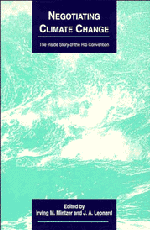Book contents
- Frontmatter
- Contents
- Acknowledgements
- Commonly Used Acronyms
- Foreword
- Part I Background
- Part II Views from Within the Ring
- 3 Exercising Common but Differentiated Responsibility
- 4 The Beginnings of an International Climate Law
- 5 Constructive Damage to the Status Quo
- 6 The Climate Change Negotiations
- 7 A Personal Assessment
- 8 The Road to Rio
- 9 A Failure of Presidential Leadership
- 10 Looking Back to See Forward
- Part III The Outside Edges In
- Part IV Prospects for the Future
- Appendix: The Framework Convention on Climate Change
- Index
6 - The Climate Change Negotiations
Published online by Cambridge University Press: 01 June 2011
- Frontmatter
- Contents
- Acknowledgements
- Commonly Used Acronyms
- Foreword
- Part I Background
- Part II Views from Within the Ring
- 3 Exercising Common but Differentiated Responsibility
- 4 The Beginnings of an International Climate Law
- 5 Constructive Damage to the Status Quo
- 6 The Climate Change Negotiations
- 7 A Personal Assessment
- 8 The Road to Rio
- 9 A Failure of Presidential Leadership
- 10 Looking Back to See Forward
- Part III The Outside Edges In
- Part IV Prospects for the Future
- Appendix: The Framework Convention on Climate Change
- Index
Summary
Prologue
Few issues have acquired priority in the international agenda in as short a time as global warming. Up to the early 1970s many scientists believed that the Earth might be moving towards a new ice age and that increasing levels of emissions of greenhouse gases (GHGs) from human activities would not alter this course and might even be helpful in slowing down this movement. It was only towards the close of the decade that scientific opinion tentatively endorsed the view that on average global temperatures might be rising. The first World Climate Conference, organized by the World Meteorological Organization (WMO) in Geneva in 1979, cautiously concluded that:
It can be said with some confidence that the burning of fossil fuels, deforestation and changes of land use have increased the amount of carbon dioxide in the atmosphere by about 15 per cent during the last century and that it is at present increasing by about 0.4 per cent per year … it appears plausible that an increased amount of carbon dioxide in the atmosphere can contribute to a gradual warming of the lower atmosphere, especially at high latitudes.
Despite continuing uncertainties in many of its aspects, this hypothesis made rapid headway in scientific circles in the 1980s. Workshops held in Villach (Austria) in October 1985 and in October 1987, and in Bellagio (Italy) in November 1987 gave impetus to this development.
- Type
- Chapter
- Information
- Negotiating Climate ChangeThe Inside Story of the Rio Convention, pp. 129 - 148Publisher: Cambridge University PressPrint publication year: 1994
- 18
- Cited by



